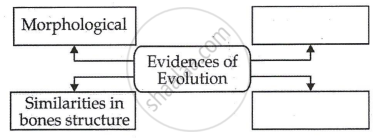Advertisements
Advertisements
Question
What do you mean by vestigial structures? Name four vestigial organs found in man.
Solution
1. Ill developed structures or structures which are of no use are sometimes found in both plants and animals. They are referred to as vestigial organs. The same organ may be functional in one organism but vestigial in another.
2. Vermiform appendix of man is one such organ. The reason could be that human ancestors were eating uncooked food with considerable amount of cellulose in it. The normal function of caecum and appendix
in mammals is the digestion of cellulose.
3. Man shows a number of other vestigial organs. About 100 have been named. A few examples are ear muscles, wisdom teeth, plica semilunaris (representing nictitating membrane of the eye), coccyx (reduced tail) etc.
4. In plants, the scale like leaves on the Indian pipe, a plant which has lost its chlorophyll and became saprophytic in nature, is vestigial.
5. There are certain flowers in which stamens do not bear anthers.
APPEARS IN
RELATED QUESTIONS
What are vestigial organs?
Differentiate between homology and analogy. Give one example of each.
(a) Select the analogous structures from the combination given below:
(i) Forelimbs of whales and bats
(ii) Eyes of octopus and mammals
(iii) Tuber of sweet potato and potato
(iv) Tuber of Bougainvillea and tendrils of Cucurbita
(b) State the kind of evolution they represent
Write the similarity between the wing of a butterfly and the wing of a bat. What do you infer from the above with reference to evolution?
“Two areas of study namely 'evolution' and 'classification' are interlinked'. Justify this statement.
If you are asked to select a group of two vegetables, out of the following, having homologous structures which one would you select?
(a) Carrot and radish
(b) Potato and sweet potato
(c) Potato and tomato
(d) Lady finger and potato
Select two pairs from the following which exhibit divergent evolution. Give reasons for your answer.
(i) Forelimbs of cheetah and mammals
(ii) Flippers of dolphins and penguins
(iii) Wings of butterflies and birds
(iv) Forelimbs of whales and mammals
Four students A, B, C and D reported the following set of organs to be homologous. Who is correct ?
(A) Wings of a bat and a butterfly
(B) Wings of a pigeon and a bat
(C) Wings of a pigeon and a butterfly
(D) Forelimbs of cow, a duck and a lizard
Explain the terms analogous and homologous organs with examples.
Attempt giving a clear definition of the term species.
Give the importance of fossil in support of organic evolution
Name two animals having homologous organs and two having analogous organs. Name these organs.
The organs which perform different functions but have the same basic structure are known as :
(a) homologous organs
(b) analogous organs
(c) homolytic organs
(d) analytic organs
The presence of which of the following types of organs in two animals indicates that they are not derived from a common ancestor?
(a) homologous organs
(b) excretory organs
(c) analogous organs
(d) reproductive organs
X, Y, and Z are three animals. The animal X can fly but animal Y can only run on ground or walls. The forelimbs of animals X and Y have the same basic design but they are used for different purposes such as flying and running respectively. The animal Z became extinct an long time ago. The study of fossils of Z tells us that it had some features like those of X and some like those of Y. In fact, Z is said to form a connecting link in the evolutionary chain of X and Y.
(a) What could the animals X, Y and Z be?
(b) What name is given to the forelimbs like those of X and Y which have the same basic design but different functions?
(c) Name one feature in which Z resembled X.
(d) Name one feature in which Z resembled Y.
(e) Which is the correct evolutionary chain involving X, Y and Z : X → Z → Y or Y → Z → X?
The organs P and Q of two animals have different structures but similar functions. On the other hand, the two organs R and S of two other animals have the same basic structure but different functions.
(a) What are the organs like P and Q known as?
(b) Name the organs like P and Q. Also name the animals which have such organs.
(c) What are the organs like R and S called?
(d) Name the organs like R and S. Also name the animals which have such organs.
What do we call the degenerated or partially developed useless organs in living organisms? Enlist such organs in human body? How the same organs are useful in other animals?
_______ is a connecting link between Annelida and Arthropoda.
With the help of diagrams, describe emasculation and bagging.
Very short answer question:
What is vestigeal organ?
Give scientific reason.
Duck-billed platypus shows relationship with mammals.
Complete the flowchart.

What is carbon dating?
Explain any five types of evidence that support the theory of evolution.
Select the CORRECT set of homologous organs.
Why do all the gametes formed in human females have an X chromosome?
Tendons and ligaments are examples of ______.
Evolutionary convergence is the development of:
The process of mating of individuals, which are more closing related than the average of the population to which they belong is called ______.
The presence of gill slits, in the embryos of all vertebrates, supports the theory of ______.
Which is not a vestigial organ in a man?
The study of fossil evidence of evolution is called ______
What are we referring to? When we say 'simple organisms' or 'complex organisms'.
Explain divergent evolution in detail. What is the driving force behind it?
Write a note on the significance of Palaeontology.
Complete the following conceptual picture:

